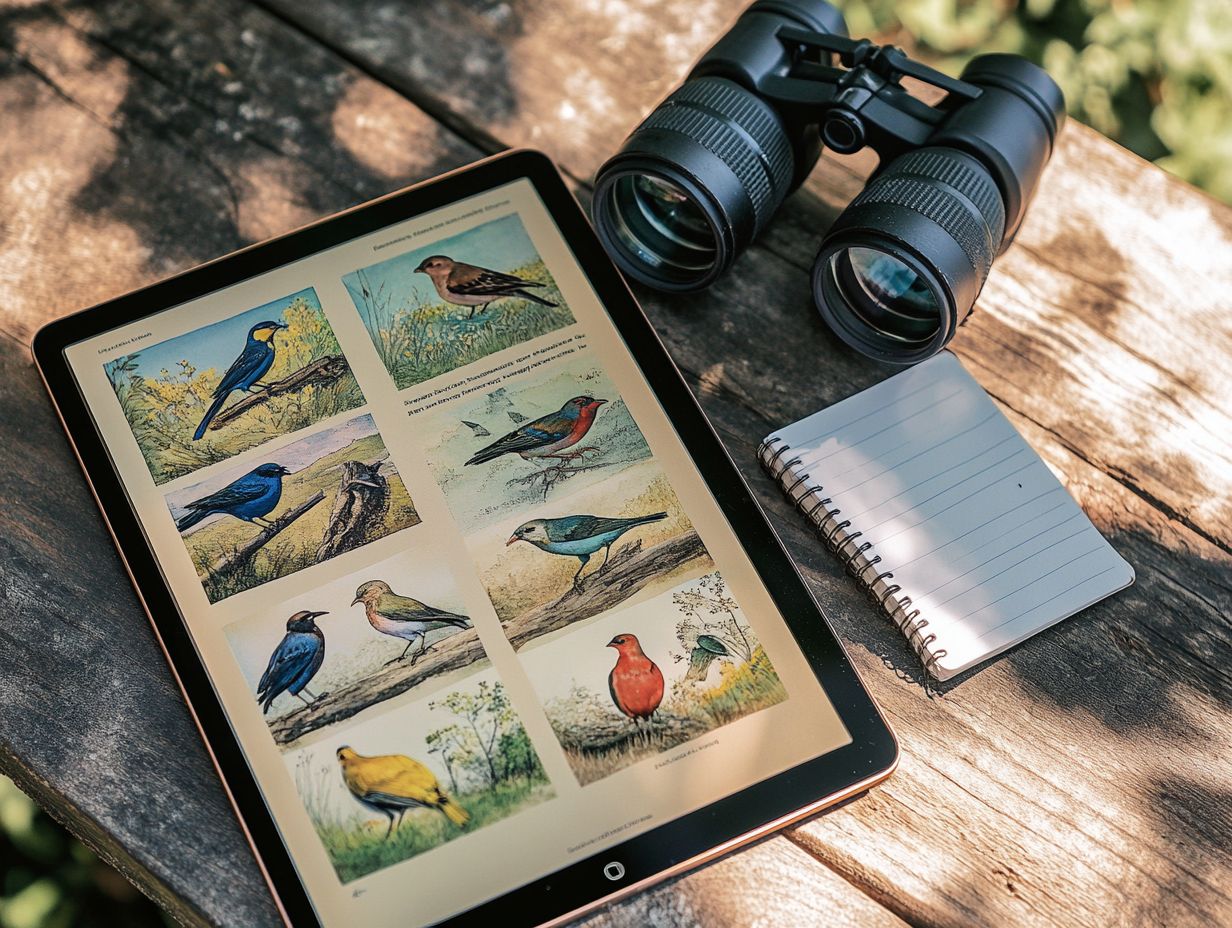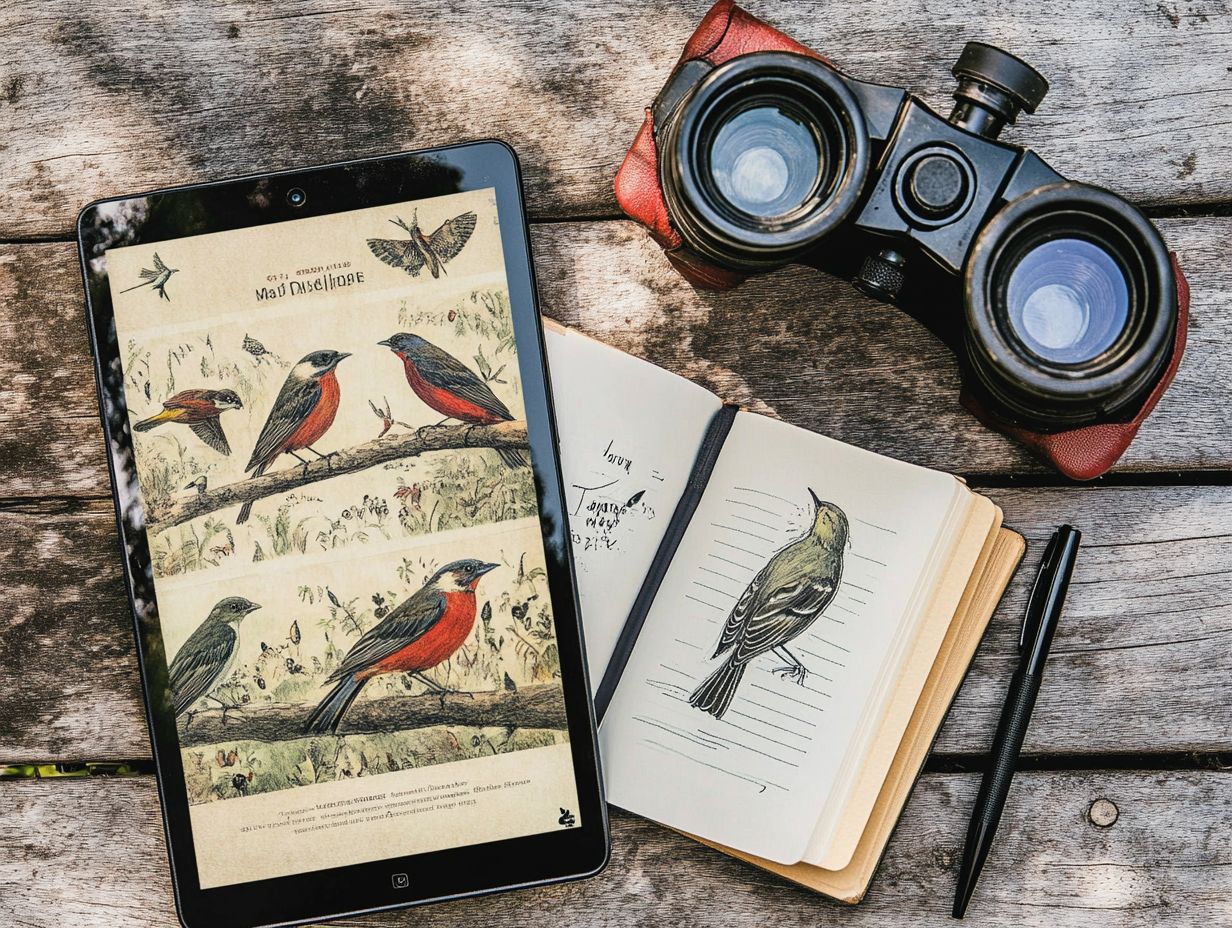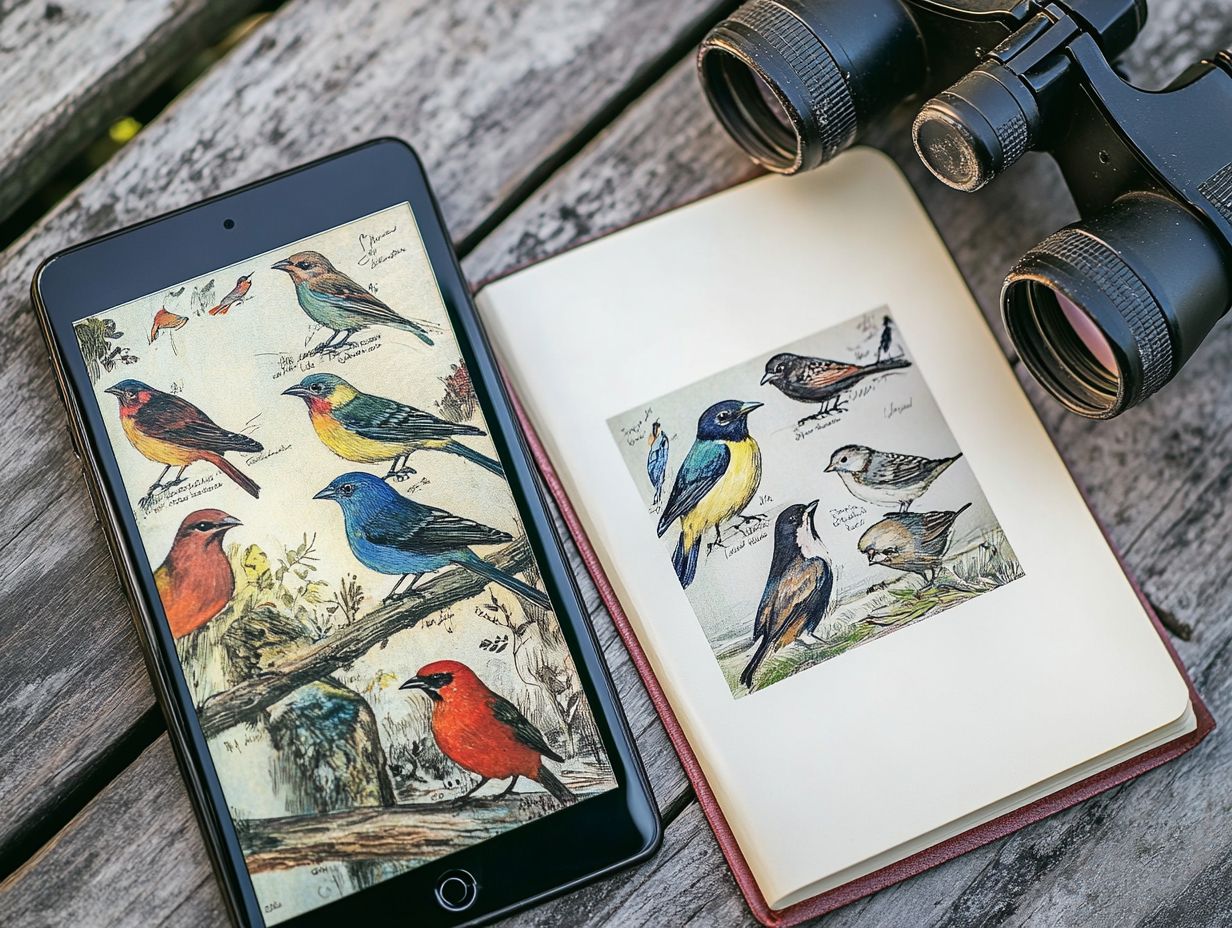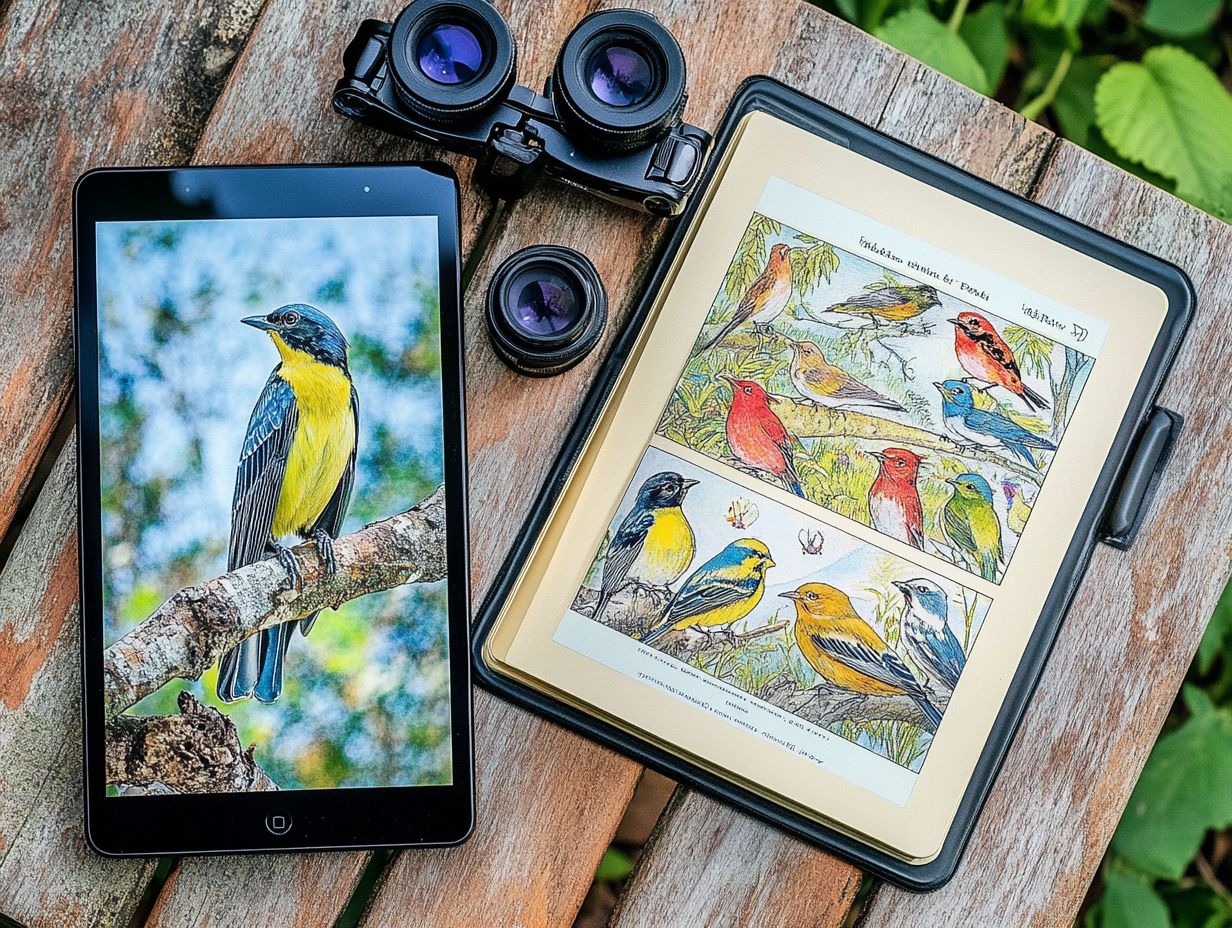Comparing Digital vs. Print Bird Field Guides
Birdwatching offers a wonderful opportunity to connect with nature. Having the right resources can truly enhance your experience.
Bird field guides are important tools for enthusiasts like you. They provide valuable information about different species and their habitats.
This article explores the two primary types of bird field guides: digital and print. It reveals their unique advantages and limitations, compares their features, and helps you identify which guide is best for your birdwatching adventures.
Dive in and find your perfect field guide today!
Contents
- Key Takeaways:
- Digital Bird Field Guides
- Print Bird Field Guides
- Comparing Digital and Print Bird Field Guides
- Which Type of Bird Field Guide is Right for You?
- Frequently Asked Questions
- What are the main differences between digital and print bird field guides?
- Are digital bird field guides more convenient than print ones?
- Which type of bird field guide offers more detailed information?
- Can I rely on digital bird field guides for accurate species identification?
- Are digital bird field guides more cost-effective than print ones?
- Can I use both digital and print bird field guides concurrently?
Key Takeaways:

- Digital bird field guides offer convenience and portability, featuring search functions and audio recordings.
- Print bird field guides provide a traditional reading experience but may have limitations in size and updated information.
- When choosing between digital and print bird field guides, consider your personal preferences, budget, and how often you go birding.
What are Bird Field Guides?
Bird field guides are important tools for birdwatchers in North America. They provide detailed information about various bird species, including their appearances and behaviors.
These invaluable guides not only help with identification but also enrich your birdwatching experience. With high-quality photographs and engaging descriptions, they allow you to connect with nature. Guides like the Sibley Guide and National Geographic offer insights that are both scientifically accurate and user-friendly.
In today’s digital age, modern options like All About Birds and smartphone apps offer interactive resources and up-to-date information for tech-savvy birders like you. Understanding the available field guides can enhance your enjoyment of this fascinating hobby.
Digital Bird Field Guides
Digital bird field guides have transformed birdwatching by providing convenience and accessibility through smartphone apps and online resources.
Tools like Merlin Bird ID and the Audubon Bird Guide empower you to identify birds effortlessly in your area, giving you immediate access to a wealth of information.
These digital guides include interactive features like stunning photographs and community forums, creating a vibrant space for birdwatching enthusiasts to connect.
With the ability to quickly search for specific birds using advanced filters, identifying species has never been easier.
Advantages and Features
Digital bird field guides offer numerous advantages that enhance your birdwatching experience. You have immediate access to a variety of resources and interactive features, showcasing how field guides change the birdwatching game compared to traditional printed guides.
This innovative approach allows you to effectively utilize tools designed to simplify the identification process. Unlike conventional books, digital guides often include augmented reality features, helping you visualize birds in their natural habitats.
With customizable checklists and community forums, you can easily track your sightings and share experiences with fellow enthusiasts. The ability to quickly update information keeps you in line with the latest research, making digital bird field guides invaluable whether you re a novice or a seasoned birder.
Start your birdwatching adventure today with the right guide in hand!
Print Bird Field Guides

Printed bird field guides are trusted companions for bird identification. They provide tangible resources that work well in the field without technology.
Renowned publications like the Sibley Guide, Peterson Guide, Kaufman Field Guide, and the National Geographic series set the gold standard for quality and accuracy in birdwatching literature.
These guides showcase stunning photographs, detailed descriptions, and essential field marks, making it easy to identify various species, including rare ones like the ivory-billed woodpecker and the Carolina parakeet, even for beginners.
The portability and easy-to-use layout of printed guides, combined with the absence of battery life concerns, make them essential for serious birdwatchers who enjoy the tactile pleasure of flipping through pages.
Benefits and Limitations
While printed bird field guides provide numerous benefits for bird identification, including the option to sketch birds you see, they also have limitations.
These guides offer detailed photographs and field marks that significantly aid in recognizing various bird species, making them popular among birdwatchers.
However, they don’t have real-time updates and may lack the latest information on bird sightings or distribution changes. This can be a disadvantage in rapidly changing environments.
Additionally, the physical nature of printed guides can make them cumbersome to carry, especially if you want to consult multiple references during your outing.
There’s something uniquely satisfying about flipping through the pages of a guide. This tactile experience enhances focus and engagement, allowing for a deeper connection with the material.
In contrast, while digital alternatives offer convenience and real-time information through apps and online databases like All About Birds, they can sometimes lead to screen fatigue or technical issues.
The lack of smartphone notifications in printed versions allows for quicker navigation in the field, free from distractions. Ultimately, the decision between printed and digital guides is a matter of personal preference.
It’s about weighing the immediacy of digital access against the timeless charm and reliability of physical books for birdwatching, particularly for enthusiasts exploring regions like California and Texas.
Comparing Digital and Print Bird Field Guides
When considering bird field guides, your choice between digital and printed formats can significantly shape your birdwatching experience and effectiveness in identifying species across regions like the Northeast, Southeast, Midwest, NW, and SW. For a detailed selection, check out the most comprehensive bird field guides available.
Digital guides offer remarkable convenience and interactivity, featuring:
- Convenient access
- Up-to-date information
- Interactive features
On the other hand, printed guides provide:
- A tactile experience
- Reliable information
- Traditional appeal
Each format has its unique advantages and drawbacks; understanding these distinctions is essential for selecting the guide that best aligns with your needs and preferences.
Which guide will you choose for your next birdwatching adventure?
Key Differences and Similarities
Understanding the key differences and similarities between digital and printed bird field guides is essential for making an informed choice. Digital guides often come packed with interactive features, like instant bird identification through smartphone apps and access to a wealth of online resources. For a deeper insight into the future of bird field guides in the digital age, printed guides provide a physical book that many birdwatchers find appealing.
While both formats assist with bird identification, they vary significantly in usability, updates, and overall user experience. This nuanced understanding can help you choose the right bird field guide that fits your unique needs.
In terms of usability, digital versions excel with updates, giving you the most current information on bird species and behaviors right at your fingertips. However, printed guides are often more reliable in remote areas where battery life and connectivity may be a concern. Many users appreciate the tactile experience of flipping through pages, enhancing their learning and retention.
Both formats offer unique advantages:
- Digital guides can harness multimedia content, like audio calls and videos.
- Printed guides provide a distraction-free experience, allowing you to immerse yourself fully in your surroundings without interruptions from technology.
This comparison is crucial for birdwatchers eager to enhance their adventures, whether you re exploring the East or West.
Which Type of Bird Field Guide is Right for You?

Choosing the right type of bird field guide, whether digital or printed, is essential for enhancing your birdwatching experience. Several factors can influence this decision, including your birdwatching style, how often you venture into the field, and the specific environments you explore.
Your environment can significantly affect which guide is the best fit. If you enjoy wandering remote areas with scarce internet access, a printed guide may be more reliable. Conversely, if you appreciate the convenience of carrying multiple resources or need interactive identification tools that help you identify birds using photos and sounds, you might find the evolution of bird field guides over time to be the superior option.
Factors to Consider for Choosing a Guide
When selecting a bird field guide, several factors come into play that can elevate your birdwatching experience and improve your bird identification skills. Your personal preference is key; you might enjoy the tactile pleasure of flipping through a printed guide, while others may prefer the convenience of digital guides.
Reflect on your usual birdwatching spots. Will a printed guide suffice, or do you need the updates that digital formats provide? Consider your level of expertise as well; beginners often gain more from guides filled with detailed explanations and vivid photographs.
Accessibility is crucial; an easy-to-use guide can significantly enhance your experience. Think about whether you prefer a guide that organizes birds by region, species, or habitat, as this choice will affect your ability to quickly identify a bird on the move.
Evaluate features in each format like interactive maps and audio calls in digital versions against the simpler yet often more durable pages of printed guides. Lastly, consider how often you plan to indulge in birdwatching; investing in a high-quality guide, such as one that offers understanding bird identification with field guides, can greatly enrich your understanding and appreciation of avian species across different environments.
Frequently Asked Questions
What are the main differences between digital and print bird field guides?
Digital bird field guides are electronic versions of traditional print guides accessible on devices like smartphones, tablets, or e-readers. While both types provide information on bird species, top features to look for in a bird field guide highlight how digital guides offer benefits like search functions, multimedia content, and real-time updates.
Why choose digital bird guides? Digital guides provide convenience and interactive tools that enhance your birdwatching experience. Don’t miss out on the latest features explore digital guides today!
Are digital bird field guides more convenient than print ones?

Your choice depends on what you find most convenient! Digital guides are portable, letting birders carry a wealth of information in their pockets.
Print guides don’t require battery life or internet, making them reliable in remote locations.
Which type of bird field guide offers more detailed information?
Print guides usually provide comprehensive information on bird species. They include detailed descriptions, illustrations, and behavioral insights.
Digital guides may offer limited space and basic facts, so they might not cover everything.
Can I rely on digital bird field guides for accurate species identification?
Digital guides can help identify birds, but they shouldn’t be the only resource. Transitioning from field guides to birding apps is valuable, yet print guides provide physical illustrations and descriptions for easier comparison in the field.
Using both types of guides is the best way to ensure accurate identification.
Are digital bird field guides more cost-effective than print ones?
The answer varies based on the guide and device. Some digital guides may be cheaper, but others could require you to buy a device.
Print guides also vary in price, depending on size and detail.
Can I use both digital and print bird field guides concurrently?
Absolutely! Many birders use both types together. Digital guides offer quick access, while print guides provide deeper knowledge.
It’s up to you whether to use one or both in the field!






